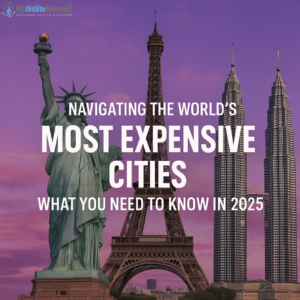In an increasingly globalized world, many people dream of living in major cities known for their opportunities, culture, and prestige. However, those dreams often come with a steep price. Each year, organizations analyze global economic data to determine the most expensive cities to live in—and 2025 is no exception.
If you’re planning a move, investing in real estate, or just curious about where your city stands, it’s worth understanding what drives up living costs and how certain cities continue to dominate the global rankings.
The World’s Costliest Cities in 2025
According to The Economist Intelligence Unit’s (EIU) Worldwide Cost of Living report, Zurich and Singapore are tied for the title of the most expensive cities in the world this year. These cities have long been associated with high standards of living, advanced infrastructure, and robust economies—qualities that often come at a financial premium.
Trailing closely behind are New York City and Geneva, with Hong Kong, Los Angeles, Paris, Tel Aviv, Copenhagen, and San Francisco rounding out the top ten. These cities are not only hubs of global finance and innovation but also feature high housing costs, elevated prices for consumer goods, and strong currencies that amplify living expenses.
What’s Driving the Costs?
Several key factors influence the high cost of living in these cities:
-
Housing Prices: In most of these cities, especially in places like San Francisco, Geneva, and Hong Kong, housing is a major expense. Limited space, strong demand, and investment-focused real estate markets continue to drive prices upward.
-
Currency Strength: A stronger local currency compared to the U.S. dollar or euro can make a city more expensive for foreigners and travelers.
-
Consumer Prices: From groceries to transportation, cities with higher wages and greater economic activity often see price inflation in everyday goods and services.
-
Global Demand: Cities with strong reputations—financially, culturally, or politically—often attract high-net-worth individuals, pushing prices even higher.
The U.S. Cities Dominating the Domestic Charts
In the U.S., California’s Bay Area is once again among the most expensive regions to live in. According to data from SmartAsset, to live comfortably in:
-
San Jose, a single adult needs $147,430 annually, while a family of four would need $371,571.
-
San Francisco and Oakland aren’t far behind, with similarly steep living expenses.
Despite these daunting figures, the Bay Area’s tech industry offers lucrative salaries. In fact, approximately 1 in every 48 jobs in the region pays over $500,000 annually. This balance between high costs and high earning potential is part of what makes the area so appealing—and so exclusive.
Source: SFGate – Bay Area cities dominate list of most expensive places to live
Monaco: Where Real Estate Meets Luxury
For those interested in the luxury real estate market, Monaco stands in a league of its own. The 2025 Knight Frank Wealth Report reveals that $1 million in Monaco only gets you 19 square meters of prime real estate—roughly the size of a small parking space.
By comparison:
-
In New York, the same amount would buy 34 square meters.
-
In London, about 34.5 square meters.
-
In Tokyo, over 60 square meters.
Monaco’s limited land supply, combined with its reputation as a tax haven and playground for the ultra-wealthy, continues to fuel one of the most expensive property markets in the world.
Source: Business Insider – Monaco remains the world’s most expensive property market
Should You Move to One of These Cities?
Living in a world-class city is an exciting opportunity, but it’s important to weigh the pros and cons.
Pros:
-
Access to top-tier job markets, especially in finance, tech, and entertainment.
-
Cultural vibrancy and diverse communities.
-
Exceptional infrastructure, education, and healthcare options.
Cons:
-
High cost of rent or mortgage payments.
-
Pricey daily expenses, from groceries to gas.
-
Potentially stressful competition and fast-paced lifestyles.
For digital nomads, high-income professionals, or those relocating for career opportunities, these cities may be worth the investment. But for others, the high costs could outweigh the benefits, especially if remote work or smaller cities offer similar career potential and better quality of life.
Final Thoughts
Understanding the world’s most expensive cities helps us put global economics into perspective. Whether you’re budgeting for a move, investing in property, or simply staying informed, it’s clear that cost of living will continue to shape where—and how—we choose to live.
Source: The Most Expensive Cities to Live in This Year—Is Yours on the List?

